Completing the Application for Divorce: A Step-by-Step Guide
VerifiedAdded on 2021/04/24
|37
|10715
|30
Homework Assignment
AI Summary
This document is a comprehensive guide to the divorce application process in Australia, specifically for the Family Court of Australia and the Federal Circuit Court of Australia. It outlines the necessary steps, from completing the application form to attending the hearing, and includes a glossary of legal terms, helpful information, and a checklist. The guide explains who can apply for a divorce (sole or joint application), when to apply, and the responsibilities of the applicant. It covers the required documents, filing procedures, fees, and the process of receiving a hearing date. The document emphasizes the importance of seeking legal advice, organizing paperwork, and answering all questions accurately. It also details the outcomes of the hearing and provides links to additional resources, such as the Commonwealth Courts Portal and eFiling instructions. This document serves as a valuable resource for individuals navigating the divorce process, offering clarity and guidance on the legal requirements and procedures involved.
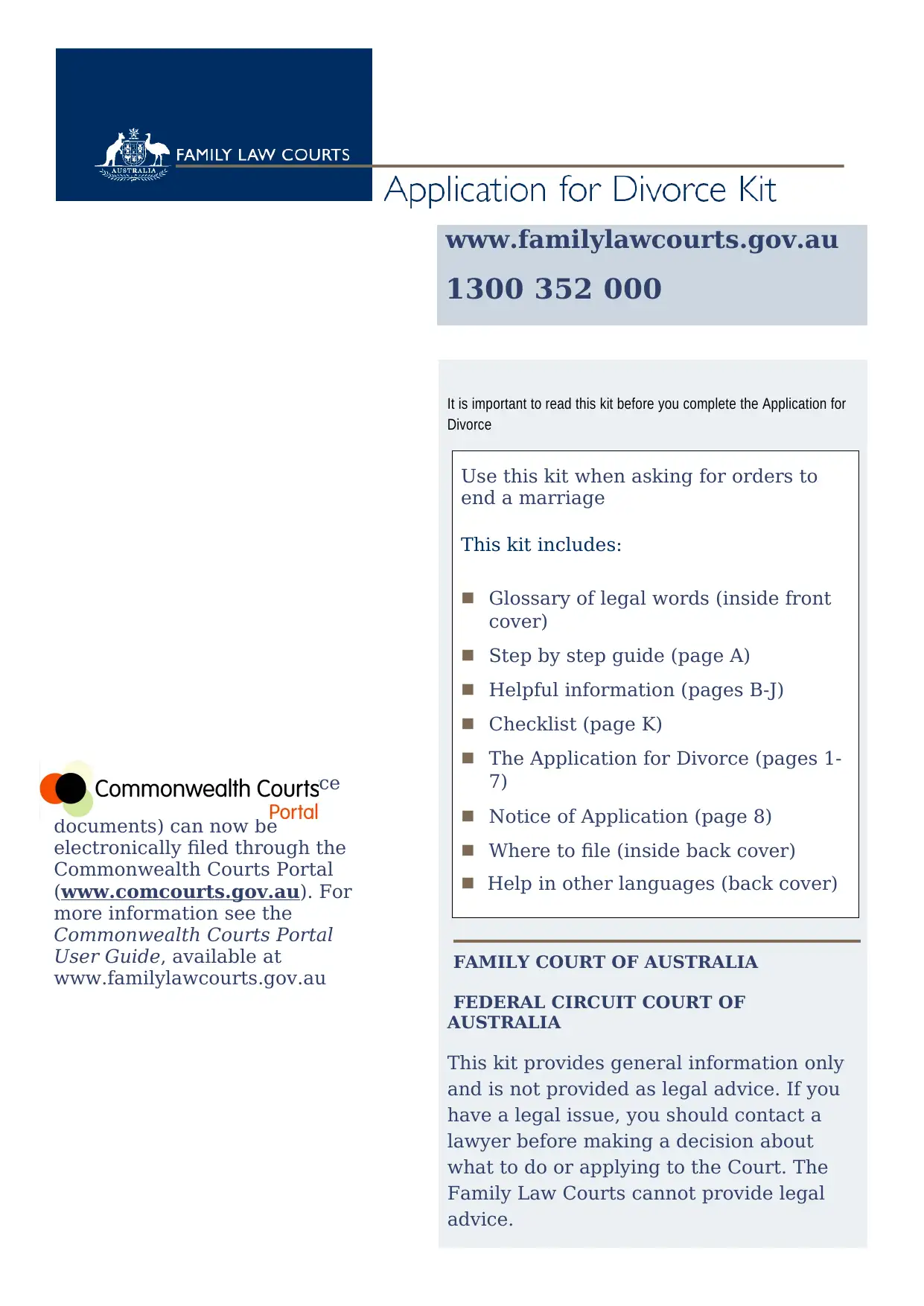
www.familylawcourts.gov.au
1300 352 000
It is important to read this kit before you complete the Application for
Divorce
Use this kit when asking for orders to
end a marriage
This kit includes:
Glossary of legal words (inside front
cover)
Step by step guide (page A)
Helpful information (pages B-J)
Checklist (page K)
The Application for Divorce (pages 1-
7)
Notice of Application (page 8)
Where to file (inside back cover)
Help in other languages (back cover)
FAMILY COURT OF AUSTRALIA
FEDERAL CIRCUIT COURT OF
AUSTRALIA
This kit provides general information only
and is not provided as legal advice. If you
have a legal issue, you should contact a
lawyer before making a decision about
what to do or applying to the Court. The
Family Law Courts cannot provide legal
advice.
Note: Applications for Divorce
(and certain accompanying
documents) can now be
electronically filed through the
Commonwealth Courts Portal
(www.comcourts.gov.au). For
more information see the
Commonwealth Courts Portal
User Guide, available at
www.familylawcourts.gov.au
1300 352 000
It is important to read this kit before you complete the Application for
Divorce
Use this kit when asking for orders to
end a marriage
This kit includes:
Glossary of legal words (inside front
cover)
Step by step guide (page A)
Helpful information (pages B-J)
Checklist (page K)
The Application for Divorce (pages 1-
7)
Notice of Application (page 8)
Where to file (inside back cover)
Help in other languages (back cover)
FAMILY COURT OF AUSTRALIA
FEDERAL CIRCUIT COURT OF
AUSTRALIA
This kit provides general information only
and is not provided as legal advice. If you
have a legal issue, you should contact a
lawyer before making a decision about
what to do or applying to the Court. The
Family Law Courts cannot provide legal
advice.
Note: Applications for Divorce
(and certain accompanying
documents) can now be
electronically filed through the
Commonwealth Courts Portal
(www.comcourts.gov.au). For
more information see the
Commonwealth Courts Portal
User Guide, available at
www.familylawcourts.gov.au
Paraphrase This Document
Need a fresh take? Get an instant paraphrase of this document with our AI Paraphraser

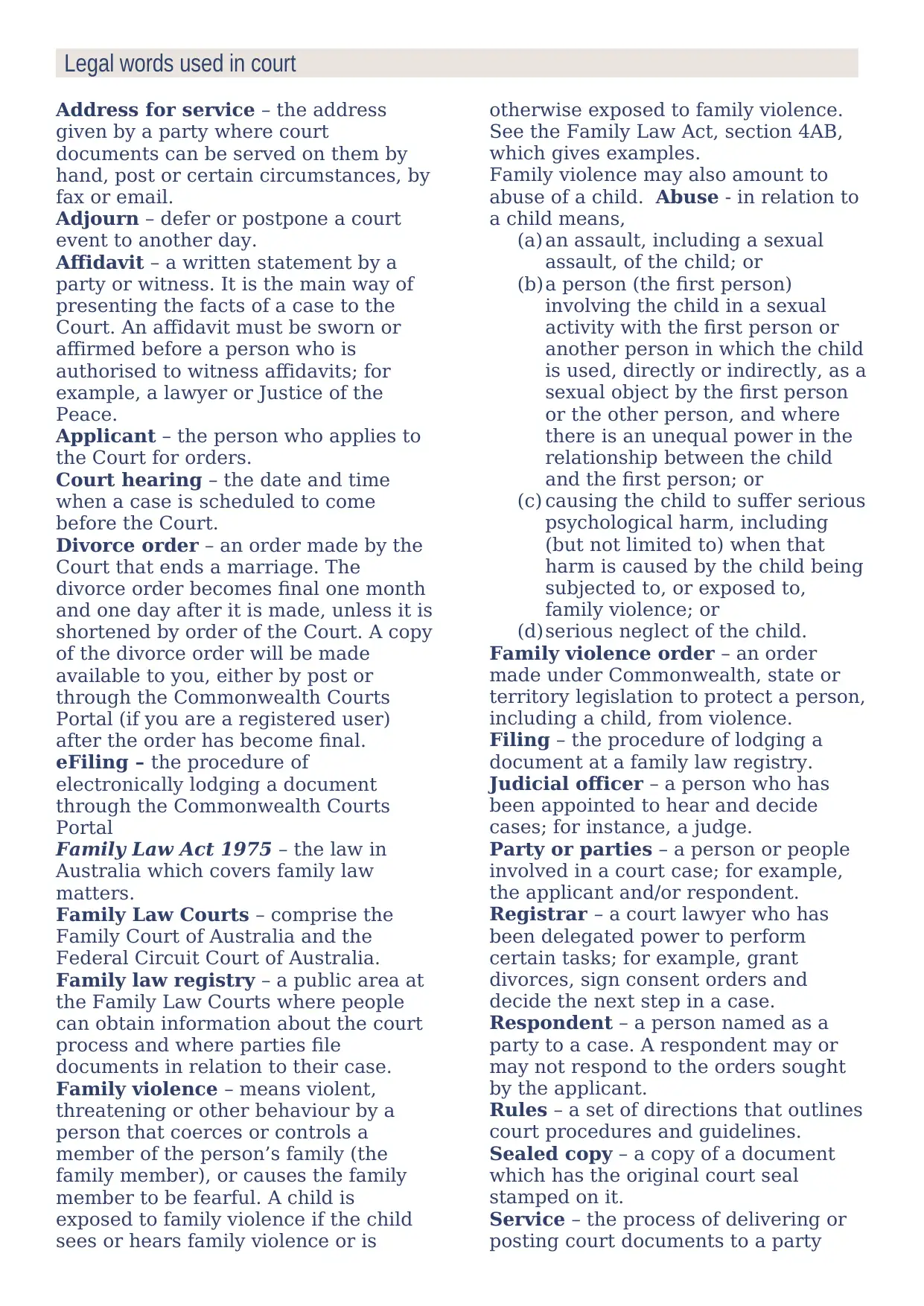
Legal words used in court
Address for service – the address
given by a party where court
documents can be served on them by
hand, post or certain circumstances, by
fax or email.
Adjourn – defer or postpone a court
event to another day.
Affidavit – a written statement by a
party or witness. It is the main way of
presenting the facts of a case to the
Court. An affidavit must be sworn or
affirmed before a person who is
authorised to witness affidavits; for
example, a lawyer or Justice of the
Peace.
Applicant – the person who applies to
the Court for orders.
Court hearing – the date and time
when a case is scheduled to come
before the Court.
Divorce order – an order made by the
Court that ends a marriage. The
divorce order becomes final one month
and one day after it is made, unless it is
shortened by order of the Court. A copy
of the divorce order will be made
available to you, either by post or
through the Commonwealth Courts
Portal (if you are a registered user)
after the order has become final.
eFiling – the procedure of
electronically lodging a document
through the Commonwealth Courts
Portal
Family Law Act 1975 – the law in
Australia which covers family law
matters.
Family Law Courts – comprise the
Family Court of Australia and the
Federal Circuit Court of Australia.
Family law registry – a public area at
the Family Law Courts where people
can obtain information about the court
process and where parties file
documents in relation to their case.
Family violence – means violent,
threatening or other behaviour by a
person that coerces or controls a
member of the person’s family (the
family member), or causes the family
member to be fearful. A child is
exposed to family violence if the child
sees or hears family violence or is
otherwise exposed to family violence.
See the Family Law Act, section 4AB,
which gives examples.
Family violence may also amount to
abuse of a child. Abuse - in relation to
a child means,
(a) an assault, including a sexual
assault, of the child; or
(b)a person (the first person)
involving the child in a sexual
activity with the first person or
another person in which the child
is used, directly or indirectly, as a
sexual object by the first person
or the other person, and where
there is an unequal power in the
relationship between the child
and the first person; or
(c) causing the child to suffer serious
psychological harm, including
(but not limited to) when that
harm is caused by the child being
subjected to, or exposed to,
family violence; or
(d)serious neglect of the child.
Family violence order – an order
made under Commonwealth, state or
territory legislation to protect a person,
including a child, from violence.
Filing – the procedure of lodging a
document at a family law registry.
Judicial officer – a person who has
been appointed to hear and decide
cases; for instance, a judge.
Party or parties – a person or people
involved in a court case; for example,
the applicant and/or respondent.
Registrar – a court lawyer who has
been delegated power to perform
certain tasks; for example, grant
divorces, sign consent orders and
decide the next step in a case.
Respondent – a person named as a
party to a case. A respondent may or
may not respond to the orders sought
by the applicant.
Rules – a set of directions that outlines
court procedures and guidelines.
Sealed copy – a copy of a document
which has the original court seal
stamped on it.
Service – the process of delivering or
posting court documents to a party
Address for service – the address
given by a party where court
documents can be served on them by
hand, post or certain circumstances, by
fax or email.
Adjourn – defer or postpone a court
event to another day.
Affidavit – a written statement by a
party or witness. It is the main way of
presenting the facts of a case to the
Court. An affidavit must be sworn or
affirmed before a person who is
authorised to witness affidavits; for
example, a lawyer or Justice of the
Peace.
Applicant – the person who applies to
the Court for orders.
Court hearing – the date and time
when a case is scheduled to come
before the Court.
Divorce order – an order made by the
Court that ends a marriage. The
divorce order becomes final one month
and one day after it is made, unless it is
shortened by order of the Court. A copy
of the divorce order will be made
available to you, either by post or
through the Commonwealth Courts
Portal (if you are a registered user)
after the order has become final.
eFiling – the procedure of
electronically lodging a document
through the Commonwealth Courts
Portal
Family Law Act 1975 – the law in
Australia which covers family law
matters.
Family Law Courts – comprise the
Family Court of Australia and the
Federal Circuit Court of Australia.
Family law registry – a public area at
the Family Law Courts where people
can obtain information about the court
process and where parties file
documents in relation to their case.
Family violence – means violent,
threatening or other behaviour by a
person that coerces or controls a
member of the person’s family (the
family member), or causes the family
member to be fearful. A child is
exposed to family violence if the child
sees or hears family violence or is
otherwise exposed to family violence.
See the Family Law Act, section 4AB,
which gives examples.
Family violence may also amount to
abuse of a child. Abuse - in relation to
a child means,
(a) an assault, including a sexual
assault, of the child; or
(b)a person (the first person)
involving the child in a sexual
activity with the first person or
another person in which the child
is used, directly or indirectly, as a
sexual object by the first person
or the other person, and where
there is an unequal power in the
relationship between the child
and the first person; or
(c) causing the child to suffer serious
psychological harm, including
(but not limited to) when that
harm is caused by the child being
subjected to, or exposed to,
family violence; or
(d)serious neglect of the child.
Family violence order – an order
made under Commonwealth, state or
territory legislation to protect a person,
including a child, from violence.
Filing – the procedure of lodging a
document at a family law registry.
Judicial officer – a person who has
been appointed to hear and decide
cases; for instance, a judge.
Party or parties – a person or people
involved in a court case; for example,
the applicant and/or respondent.
Registrar – a court lawyer who has
been delegated power to perform
certain tasks; for example, grant
divorces, sign consent orders and
decide the next step in a case.
Respondent – a person named as a
party to a case. A respondent may or
may not respond to the orders sought
by the applicant.
Rules – a set of directions that outlines
court procedures and guidelines.
Sealed copy – a copy of a document
which has the original court seal
stamped on it.
Service – the process of delivering or
posting court documents to a party
⊘ This is a preview!⊘
Do you want full access?
Subscribe today to unlock all pages.

Trusted by 1+ million students worldwide

after they have been filed, in
accordance with the rules of court.
Service ensures that all parties have
received the documents filed with the
Court.
Spouse – husband or wife.
Legal advice
You should seek legal advice before
deciding what to do. A lawyer can help
you understand your legal rights and
responsibilities, and explain how the
law applies to your case.
You can seek legal advice from a legal
aid office, community legal centre or
private law firm.
If you are an Aboriginal or Torres Strait
Islander, you can also contact your
local Aboriginal or Torres Strait
Islander legal service.
Court staff can help you with questions
about court forms and the court process,
but cannot give you legal advice.
accordance with the rules of court.
Service ensures that all parties have
received the documents filed with the
Court.
Spouse – husband or wife.
Legal advice
You should seek legal advice before
deciding what to do. A lawyer can help
you understand your legal rights and
responsibilities, and explain how the
law applies to your case.
You can seek legal advice from a legal
aid office, community legal centre or
private law firm.
If you are an Aboriginal or Torres Strait
Islander, you can also contact your
local Aboriginal or Torres Strait
Islander legal service.
Court staff can help you with questions
about court forms and the court process,
but cannot give you legal advice.
Paraphrase This Document
Need a fresh take? Get an instant paraphrase of this document with our AI Paraphraser
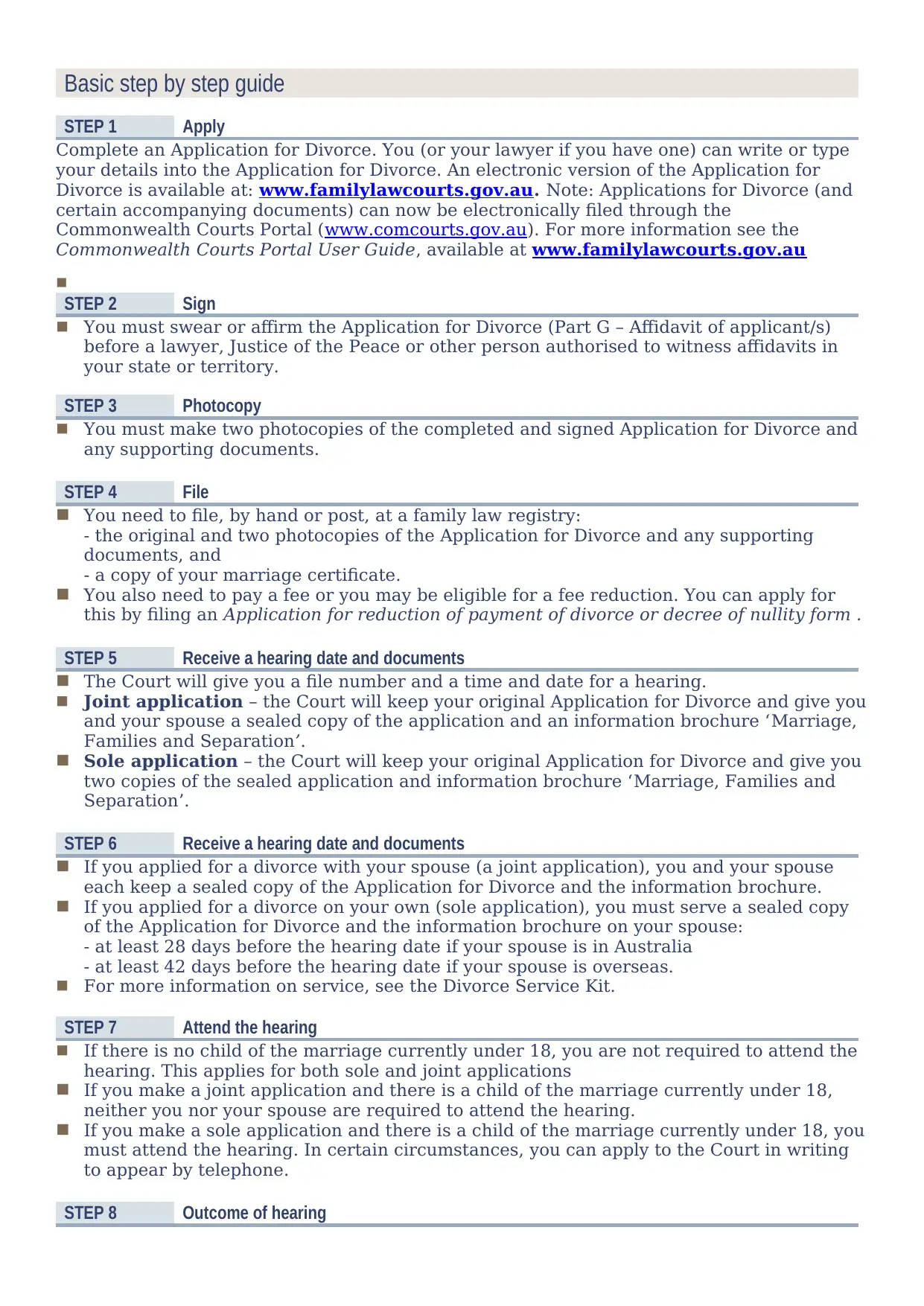
Basic step by step guide
STEP 1 Apply
Complete an Application for Divorce. You (or your lawyer if you have one) can write or type
your details into the Application for Divorce. An electronic version of the Application for
Divorce is available at: www.familylawcourts.gov.au. Note: Applications for Divorce (and
certain accompanying documents) can now be electronically filed through the
Commonwealth Courts Portal (www.comcourts.gov.au). For more information see the
Commonwealth Courts Portal User Guide, available at www.familylawcourts.gov.au
STEP 2 Sign
You must swear or affirm the Application for Divorce (Part G – Affidavit of applicant/s)
before a lawyer, Justice of the Peace or other person authorised to witness affidavits in
your state or territory.
STEP 3 Photocopy
You must make two photocopies of the completed and signed Application for Divorce and
any supporting documents.
STEP 4 File
You need to file, by hand or post, at a family law registry:
- the original and two photocopies of the Application for Divorce and any supporting
documents, and
- a copy of your marriage certificate.
You also need to pay a fee or you may be eligible for a fee reduction. You can apply for
this by filing an Application for reduction of payment of divorce or decree of nullity form .
STEP 5 Receive a hearing date and documents
The Court will give you a file number and a time and date for a hearing.
Joint application – the Court will keep your original Application for Divorce and give you
and your spouse a sealed copy of the application and an information brochure ‘Marriage,
Families and Separation’.
Sole application – the Court will keep your original Application for Divorce and give you
two copies of the sealed application and information brochure ‘Marriage, Families and
Separation’.
STEP 6 Receive a hearing date and documents
If you applied for a divorce with your spouse (a joint application), you and your spouse
each keep a sealed copy of the Application for Divorce and the information brochure.
If you applied for a divorce on your own (sole application), you must serve a sealed copy
of the Application for Divorce and the information brochure on your spouse:
- at least 28 days before the hearing date if your spouse is in Australia
- at least 42 days before the hearing date if your spouse is overseas.
For more information on service, see the Divorce Service Kit.
STEP 7 Attend the hearing
If there is no child of the marriage currently under 18, you are not required to attend the
hearing. This applies for both sole and joint applications
If you make a joint application and there is a child of the marriage currently under 18,
neither you nor your spouse are required to attend the hearing.
If you make a sole application and there is a child of the marriage currently under 18, you
must attend the hearing. In certain circumstances, you can apply to the Court in writing
to appear by telephone.
STEP 8 Outcome of hearing
STEP 1 Apply
Complete an Application for Divorce. You (or your lawyer if you have one) can write or type
your details into the Application for Divorce. An electronic version of the Application for
Divorce is available at: www.familylawcourts.gov.au. Note: Applications for Divorce (and
certain accompanying documents) can now be electronically filed through the
Commonwealth Courts Portal (www.comcourts.gov.au). For more information see the
Commonwealth Courts Portal User Guide, available at www.familylawcourts.gov.au
STEP 2 Sign
You must swear or affirm the Application for Divorce (Part G – Affidavit of applicant/s)
before a lawyer, Justice of the Peace or other person authorised to witness affidavits in
your state or territory.
STEP 3 Photocopy
You must make two photocopies of the completed and signed Application for Divorce and
any supporting documents.
STEP 4 File
You need to file, by hand or post, at a family law registry:
- the original and two photocopies of the Application for Divorce and any supporting
documents, and
- a copy of your marriage certificate.
You also need to pay a fee or you may be eligible for a fee reduction. You can apply for
this by filing an Application for reduction of payment of divorce or decree of nullity form .
STEP 5 Receive a hearing date and documents
The Court will give you a file number and a time and date for a hearing.
Joint application – the Court will keep your original Application for Divorce and give you
and your spouse a sealed copy of the application and an information brochure ‘Marriage,
Families and Separation’.
Sole application – the Court will keep your original Application for Divorce and give you
two copies of the sealed application and information brochure ‘Marriage, Families and
Separation’.
STEP 6 Receive a hearing date and documents
If you applied for a divorce with your spouse (a joint application), you and your spouse
each keep a sealed copy of the Application for Divorce and the information brochure.
If you applied for a divorce on your own (sole application), you must serve a sealed copy
of the Application for Divorce and the information brochure on your spouse:
- at least 28 days before the hearing date if your spouse is in Australia
- at least 42 days before the hearing date if your spouse is overseas.
For more information on service, see the Divorce Service Kit.
STEP 7 Attend the hearing
If there is no child of the marriage currently under 18, you are not required to attend the
hearing. This applies for both sole and joint applications
If you make a joint application and there is a child of the marriage currently under 18,
neither you nor your spouse are required to attend the hearing.
If you make a sole application and there is a child of the marriage currently under 18, you
must attend the hearing. In certain circumstances, you can apply to the Court in writing
to appear by telephone.
STEP 8 Outcome of hearing

If your divorce application is successful, the Court will grant a divorce order. The order
becomes final one month and one day after it is made, unless it is shortened by order of
the Court. .
A copy of the divorce order will be made available to you, either by post or through the
Commonwealth Courts Portal (if you are a registered user) after the order has become
final.
A
becomes final one month and one day after it is made, unless it is shortened by order of
the Court. .
A copy of the divorce order will be made available to you, either by post or through the
Commonwealth Courts Portal (if you are a registered user) after the order has become
final.
A
⊘ This is a preview!⊘
Do you want full access?
Subscribe today to unlock all pages.

Trusted by 1+ million students worldwide
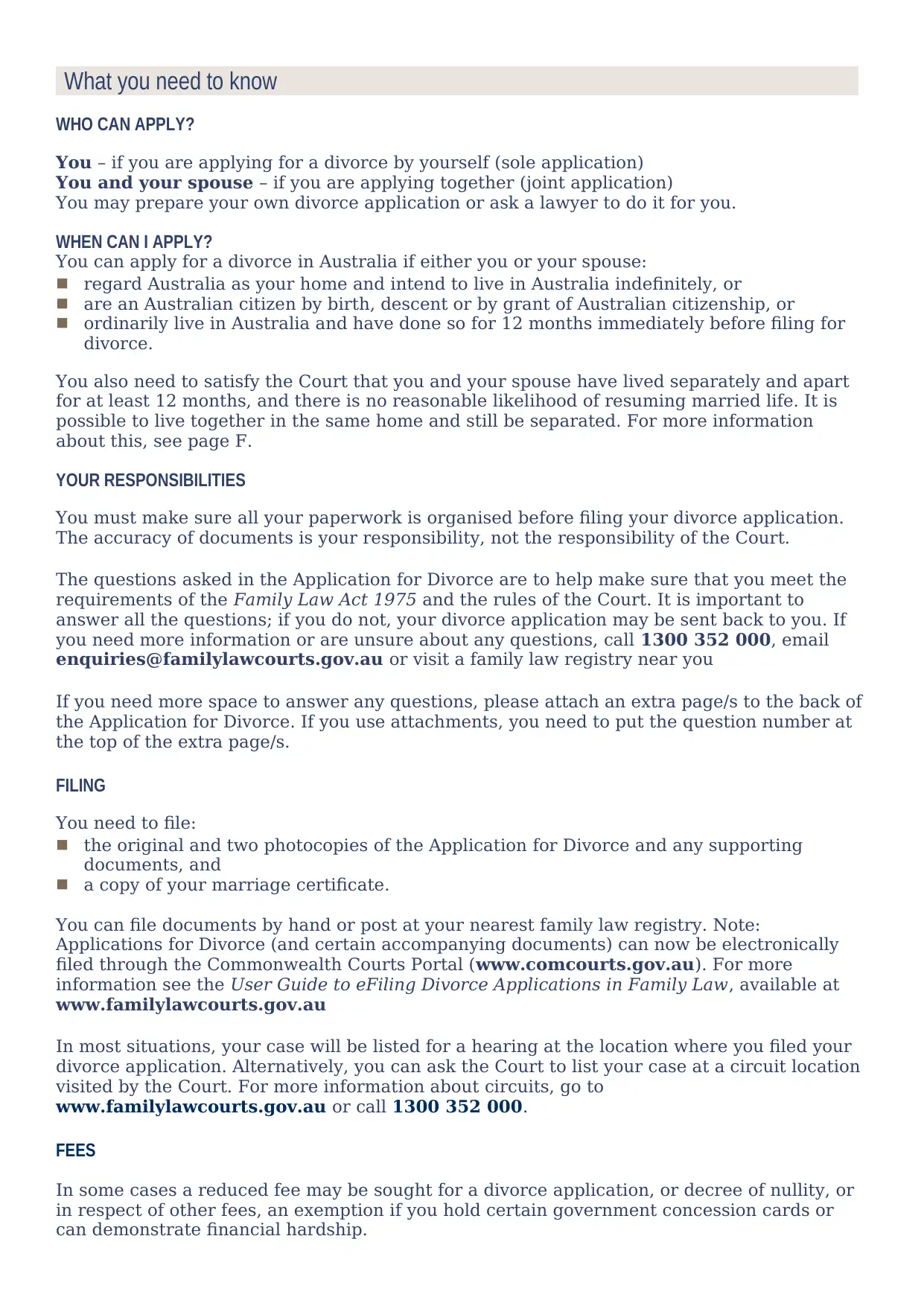
What you need to know
WHO CAN APPLY?
You – if you are applying for a divorce by yourself (sole application)
You and your spouse – if you are applying together (joint application)
You may prepare your own divorce application or ask a lawyer to do it for you.
WHEN CAN I APPLY?
You can apply for a divorce in Australia if either you or your spouse:
regard Australia as your home and intend to live in Australia indefinitely, or
are an Australian citizen by birth, descent or by grant of Australian citizenship, or
ordinarily live in Australia and have done so for 12 months immediately before filing for
divorce.
You also need to satisfy the Court that you and your spouse have lived separately and apart
for at least 12 months, and there is no reasonable likelihood of resuming married life. It is
possible to live together in the same home and still be separated. For more information
about this, see page F.
YOUR RESPONSIBILITIES
You must make sure all your paperwork is organised before filing your divorce application.
The accuracy of documents is your responsibility, not the responsibility of the Court.
The questions asked in the Application for Divorce are to help make sure that you meet the
requirements of the Family Law Act 1975 and the rules of the Court. It is important to
answer all the questions; if you do not, your divorce application may be sent back to you. If
you need more information or are unsure about any questions, call 1300 352 000, email
enquiries@familylawcourts.gov.au or visit a family law registry near you
If you need more space to answer any questions, please attach an extra page/s to the back of
the Application for Divorce. If you use attachments, you need to put the question number at
the top of the extra page/s.
FILING
You need to file:
the original and two photocopies of the Application for Divorce and any supporting
documents, and
a copy of your marriage certificate.
You can file documents by hand or post at your nearest family law registry. Note:
Applications for Divorce (and certain accompanying documents) can now be electronically
filed through the Commonwealth Courts Portal (www.comcourts.gov.au). For more
information see the User Guide to eFiling Divorce Applications in Family Law, available at
www.familylawcourts.gov.au
In most situations, your case will be listed for a hearing at the location where you filed your
divorce application. Alternatively, you can ask the Court to list your case at a circuit location
visited by the Court. For more information about circuits, go to
www.familylawcourts.gov.au or call 1300 352 000.
FEES
In some cases a reduced fee may be sought for a divorce application, or decree of nullity, or
in respect of other fees, an exemption if you hold certain government concession cards or
can demonstrate financial hardship.
WHO CAN APPLY?
You – if you are applying for a divorce by yourself (sole application)
You and your spouse – if you are applying together (joint application)
You may prepare your own divorce application or ask a lawyer to do it for you.
WHEN CAN I APPLY?
You can apply for a divorce in Australia if either you or your spouse:
regard Australia as your home and intend to live in Australia indefinitely, or
are an Australian citizen by birth, descent or by grant of Australian citizenship, or
ordinarily live in Australia and have done so for 12 months immediately before filing for
divorce.
You also need to satisfy the Court that you and your spouse have lived separately and apart
for at least 12 months, and there is no reasonable likelihood of resuming married life. It is
possible to live together in the same home and still be separated. For more information
about this, see page F.
YOUR RESPONSIBILITIES
You must make sure all your paperwork is organised before filing your divorce application.
The accuracy of documents is your responsibility, not the responsibility of the Court.
The questions asked in the Application for Divorce are to help make sure that you meet the
requirements of the Family Law Act 1975 and the rules of the Court. It is important to
answer all the questions; if you do not, your divorce application may be sent back to you. If
you need more information or are unsure about any questions, call 1300 352 000, email
enquiries@familylawcourts.gov.au or visit a family law registry near you
If you need more space to answer any questions, please attach an extra page/s to the back of
the Application for Divorce. If you use attachments, you need to put the question number at
the top of the extra page/s.
FILING
You need to file:
the original and two photocopies of the Application for Divorce and any supporting
documents, and
a copy of your marriage certificate.
You can file documents by hand or post at your nearest family law registry. Note:
Applications for Divorce (and certain accompanying documents) can now be electronically
filed through the Commonwealth Courts Portal (www.comcourts.gov.au). For more
information see the User Guide to eFiling Divorce Applications in Family Law, available at
www.familylawcourts.gov.au
In most situations, your case will be listed for a hearing at the location where you filed your
divorce application. Alternatively, you can ask the Court to list your case at a circuit location
visited by the Court. For more information about circuits, go to
www.familylawcourts.gov.au or call 1300 352 000.
FEES
In some cases a reduced fee may be sought for a divorce application, or decree of nullity, or
in respect of other fees, an exemption if you hold certain government concession cards or
can demonstrate financial hardship.
Paraphrase This Document
Need a fresh take? Get an instant paraphrase of this document with our AI Paraphraser

If you want to know more about fees, call 1300 352 000, email
enquiries@familylawcourts.gov.au or visit a family law registry near you.
B
enquiries@familylawcourts.gov.au or visit a family law registry near you.
B
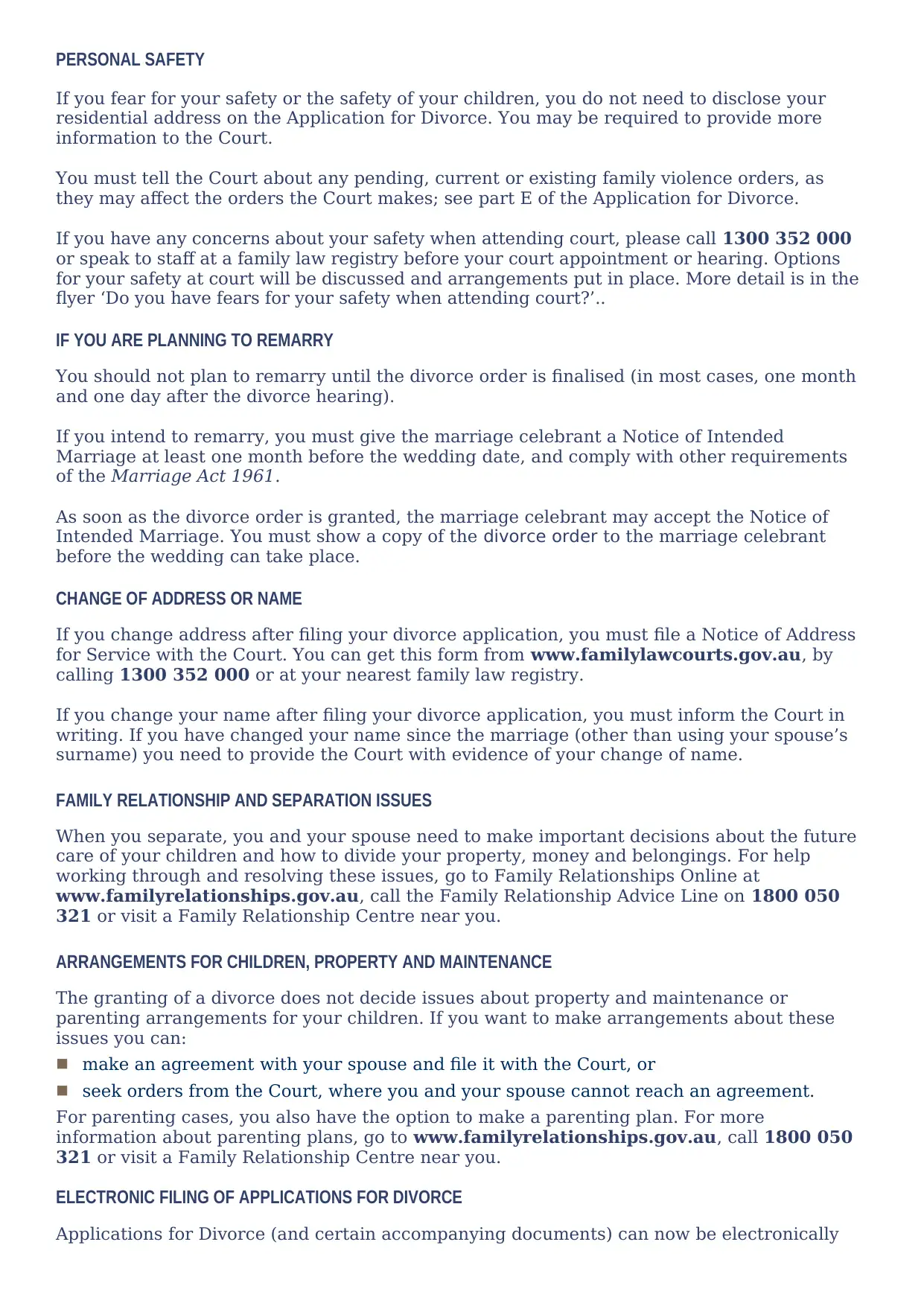
PERSONAL SAFETY
If you fear for your safety or the safety of your children, you do not need to disclose your
residential address on the Application for Divorce. You may be required to provide more
information to the Court.
You must tell the Court about any pending, current or existing family violence orders, as
they may affect the orders the Court makes; see part E of the Application for Divorce.
If you have any concerns about your safety when attending court, please call 1300 352 000
or speak to staff at a family law registry before your court appointment or hearing. Options
for your safety at court will be discussed and arrangements put in place. More detail is in the
flyer ‘Do you have fears for your safety when attending court?’..
IF YOU ARE PLANNING TO REMARRY
You should not plan to remarry until the divorce order is finalised (in most cases, one month
and one day after the divorce hearing).
If you intend to remarry, you must give the marriage celebrant a Notice of Intended
Marriage at least one month before the wedding date, and comply with other requirements
of the Marriage Act 1961.
As soon as the divorce order is granted, the marriage celebrant may accept the Notice of
Intended Marriage. You must show a copy of the divorce order to the marriage celebrant
before the wedding can take place.
CHANGE OF ADDRESS OR NAME
If you change address after filing your divorce application, you must file a Notice of Address
for Service with the Court. You can get this form from www.familylawcourts.gov.au, by
calling 1300 352 000 or at your nearest family law registry.
If you change your name after filing your divorce application, you must inform the Court in
writing. If you have changed your name since the marriage (other than using your spouse’s
surname) you need to provide the Court with evidence of your change of name.
FAMILY RELATIONSHIP AND SEPARATION ISSUES
When you separate, you and your spouse need to make important decisions about the future
care of your children and how to divide your property, money and belongings. For help
working through and resolving these issues, go to Family Relationships Online at
www.familyrelationships.gov.au, call the Family Relationship Advice Line on 1800 050
321 or visit a Family Relationship Centre near you.
ARRANGEMENTS FOR CHILDREN, PROPERTY AND MAINTENANCE
The granting of a divorce does not decide issues about property and maintenance or
parenting arrangements for your children. If you want to make arrangements about these
issues you can:
make an agreement with your spouse and file it with the Court, or
seek orders from the Court, where you and your spouse cannot reach an agreement.
For parenting cases, you also have the option to make a parenting plan. For more
information about parenting plans, go to www.familyrelationships.gov.au, call 1800 050
321 or visit a Family Relationship Centre near you.
ELECTRONIC FILING OF APPLICATIONS FOR DIVORCE
Applications for Divorce (and certain accompanying documents) can now be electronically
If you fear for your safety or the safety of your children, you do not need to disclose your
residential address on the Application for Divorce. You may be required to provide more
information to the Court.
You must tell the Court about any pending, current or existing family violence orders, as
they may affect the orders the Court makes; see part E of the Application for Divorce.
If you have any concerns about your safety when attending court, please call 1300 352 000
or speak to staff at a family law registry before your court appointment or hearing. Options
for your safety at court will be discussed and arrangements put in place. More detail is in the
flyer ‘Do you have fears for your safety when attending court?’..
IF YOU ARE PLANNING TO REMARRY
You should not plan to remarry until the divorce order is finalised (in most cases, one month
and one day after the divorce hearing).
If you intend to remarry, you must give the marriage celebrant a Notice of Intended
Marriage at least one month before the wedding date, and comply with other requirements
of the Marriage Act 1961.
As soon as the divorce order is granted, the marriage celebrant may accept the Notice of
Intended Marriage. You must show a copy of the divorce order to the marriage celebrant
before the wedding can take place.
CHANGE OF ADDRESS OR NAME
If you change address after filing your divorce application, you must file a Notice of Address
for Service with the Court. You can get this form from www.familylawcourts.gov.au, by
calling 1300 352 000 or at your nearest family law registry.
If you change your name after filing your divorce application, you must inform the Court in
writing. If you have changed your name since the marriage (other than using your spouse’s
surname) you need to provide the Court with evidence of your change of name.
FAMILY RELATIONSHIP AND SEPARATION ISSUES
When you separate, you and your spouse need to make important decisions about the future
care of your children and how to divide your property, money and belongings. For help
working through and resolving these issues, go to Family Relationships Online at
www.familyrelationships.gov.au, call the Family Relationship Advice Line on 1800 050
321 or visit a Family Relationship Centre near you.
ARRANGEMENTS FOR CHILDREN, PROPERTY AND MAINTENANCE
The granting of a divorce does not decide issues about property and maintenance or
parenting arrangements for your children. If you want to make arrangements about these
issues you can:
make an agreement with your spouse and file it with the Court, or
seek orders from the Court, where you and your spouse cannot reach an agreement.
For parenting cases, you also have the option to make a parenting plan. For more
information about parenting plans, go to www.familyrelationships.gov.au, call 1800 050
321 or visit a Family Relationship Centre near you.
ELECTRONIC FILING OF APPLICATIONS FOR DIVORCE
Applications for Divorce (and certain accompanying documents) can now be electronically
⊘ This is a preview!⊘
Do you want full access?
Subscribe today to unlock all pages.

Trusted by 1+ million students worldwide
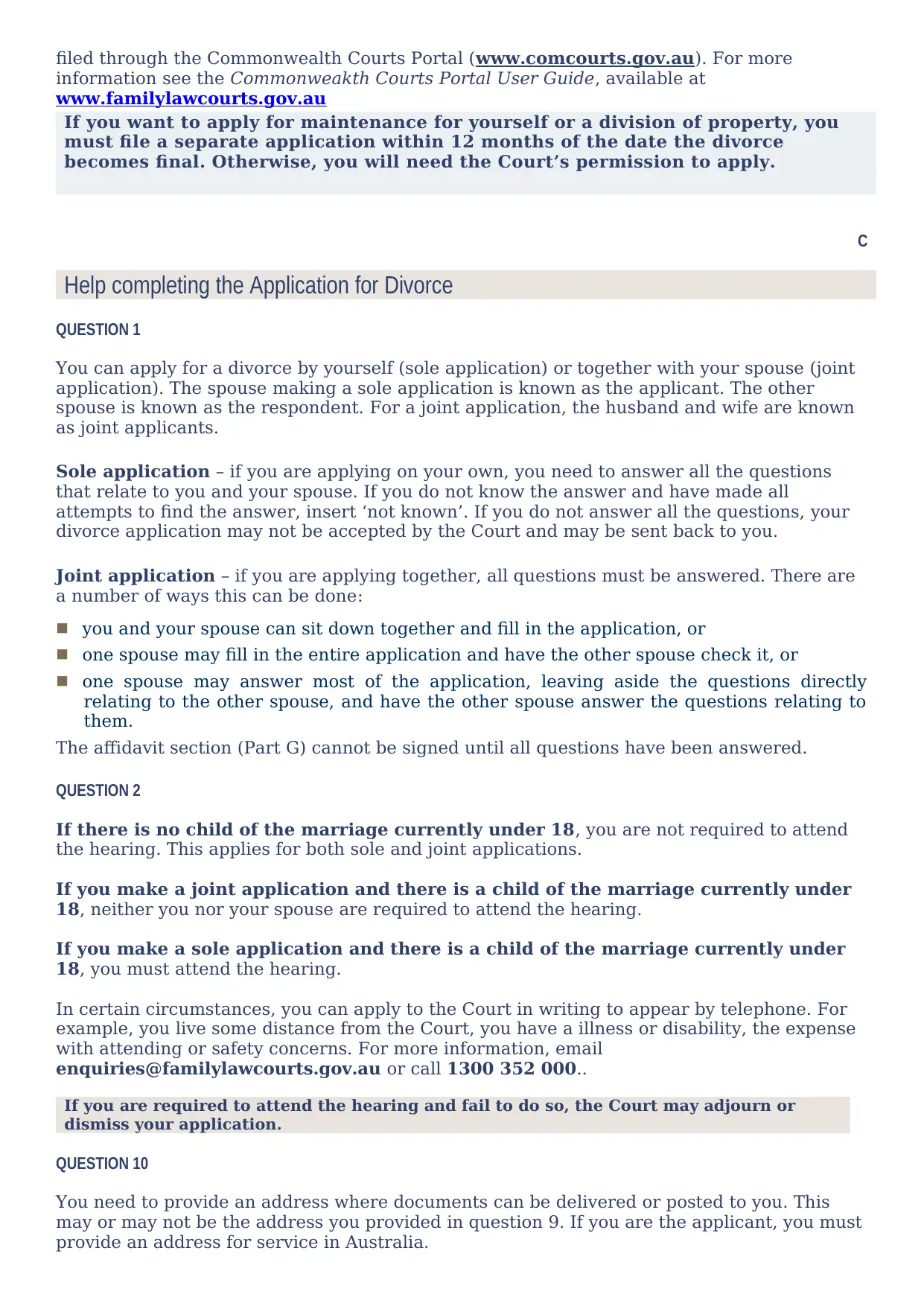
filed through the Commonwealth Courts Portal (www.comcourts.gov.au). For more
information see the Commonweakth Courts Portal User Guide, available at
www.familylawcourts.gov.au
If you want to apply for maintenance for yourself or a division of property, you
must file a separate application within 12 months of the date the divorce
becomes final. Otherwise, you will need the Court’s permission to apply.
C
Help completing the Application for Divorce
QUESTION 1
You can apply for a divorce by yourself (sole application) or together with your spouse (joint
application). The spouse making a sole application is known as the applicant. The other
spouse is known as the respondent. For a joint application, the husband and wife are known
as joint applicants.
Sole application – if you are applying on your own, you need to answer all the questions
that relate to you and your spouse. If you do not know the answer and have made all
attempts to find the answer, insert ‘not known’. If you do not answer all the questions, your
divorce application may not be accepted by the Court and may be sent back to you.
Joint application – if you are applying together, all questions must be answered. There are
a number of ways this can be done:
you and your spouse can sit down together and fill in the application, or
one spouse may fill in the entire application and have the other spouse check it, or
one spouse may answer most of the application, leaving aside the questions directly
relating to the other spouse, and have the other spouse answer the questions relating to
them.
The affidavit section (Part G) cannot be signed until all questions have been answered.
QUESTION 2
If there is no child of the marriage currently under 18, you are not required to attend
the hearing. This applies for both sole and joint applications.
If you make a joint application and there is a child of the marriage currently under
18, neither you nor your spouse are required to attend the hearing.
If you make a sole application and there is a child of the marriage currently under
18, you must attend the hearing.
In certain circumstances, you can apply to the Court in writing to appear by telephone. For
example, you live some distance from the Court, you have a illness or disability, the expense
with attending or safety concerns. For more information, email
enquiries@familylawcourts.gov.au or call 1300 352 000..
If you are required to attend the hearing and fail to do so, the Court may adjourn or
dismiss your application.
QUESTION 10
You need to provide an address where documents can be delivered or posted to you. This
may or may not be the address you provided in question 9. If you are the applicant, you must
provide an address for service in Australia.
information see the Commonweakth Courts Portal User Guide, available at
www.familylawcourts.gov.au
If you want to apply for maintenance for yourself or a division of property, you
must file a separate application within 12 months of the date the divorce
becomes final. Otherwise, you will need the Court’s permission to apply.
C
Help completing the Application for Divorce
QUESTION 1
You can apply for a divorce by yourself (sole application) or together with your spouse (joint
application). The spouse making a sole application is known as the applicant. The other
spouse is known as the respondent. For a joint application, the husband and wife are known
as joint applicants.
Sole application – if you are applying on your own, you need to answer all the questions
that relate to you and your spouse. If you do not know the answer and have made all
attempts to find the answer, insert ‘not known’. If you do not answer all the questions, your
divorce application may not be accepted by the Court and may be sent back to you.
Joint application – if you are applying together, all questions must be answered. There are
a number of ways this can be done:
you and your spouse can sit down together and fill in the application, or
one spouse may fill in the entire application and have the other spouse check it, or
one spouse may answer most of the application, leaving aside the questions directly
relating to the other spouse, and have the other spouse answer the questions relating to
them.
The affidavit section (Part G) cannot be signed until all questions have been answered.
QUESTION 2
If there is no child of the marriage currently under 18, you are not required to attend
the hearing. This applies for both sole and joint applications.
If you make a joint application and there is a child of the marriage currently under
18, neither you nor your spouse are required to attend the hearing.
If you make a sole application and there is a child of the marriage currently under
18, you must attend the hearing.
In certain circumstances, you can apply to the Court in writing to appear by telephone. For
example, you live some distance from the Court, you have a illness or disability, the expense
with attending or safety concerns. For more information, email
enquiries@familylawcourts.gov.au or call 1300 352 000..
If you are required to attend the hearing and fail to do so, the Court may adjourn or
dismiss your application.
QUESTION 10
You need to provide an address where documents can be delivered or posted to you. This
may or may not be the address you provided in question 9. If you are the applicant, you must
provide an address for service in Australia.
Paraphrase This Document
Need a fresh take? Get an instant paraphrase of this document with our AI Paraphraser
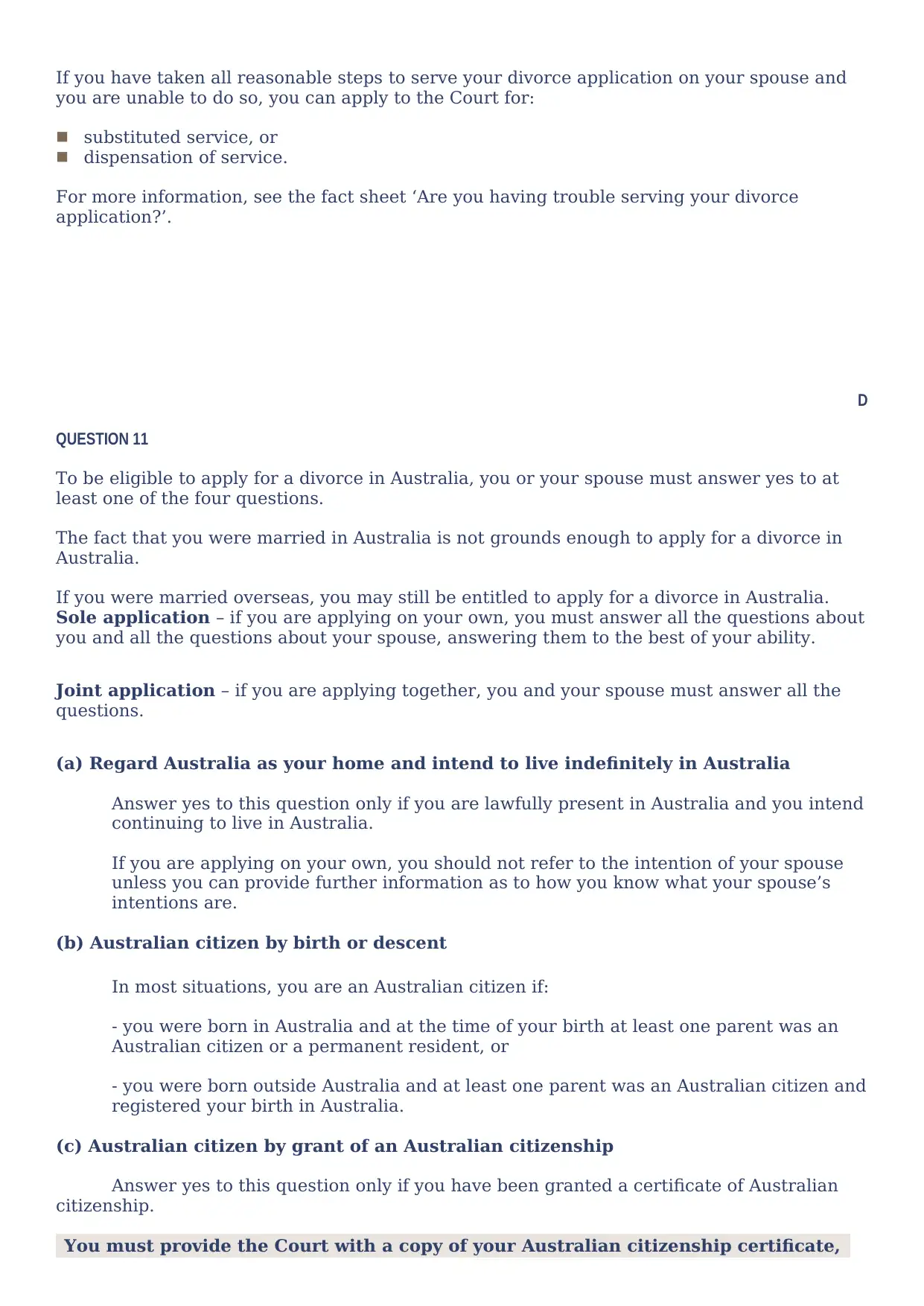
If you have taken all reasonable steps to serve your divorce application on your spouse and
you are unable to do so, you can apply to the Court for:
substituted service, or
dispensation of service.
For more information, see the fact sheet ‘Are you having trouble serving your divorce
application?’.
D
QUESTION 11
To be eligible to apply for a divorce in Australia, you or your spouse must answer yes to at
least one of the four questions.
The fact that you were married in Australia is not grounds enough to apply for a divorce in
Australia.
If you were married overseas, you may still be entitled to apply for a divorce in Australia.
Sole application – if you are applying on your own, you must answer all the questions about
you and all the questions about your spouse, answering them to the best of your ability.
Joint application – if you are applying together, you and your spouse must answer all the
questions.
(a) Regard Australia as your home and intend to live indefinitely in Australia
Answer yes to this question only if you are lawfully present in Australia and you intend
continuing to live in Australia.
If you are applying on your own, you should not refer to the intention of your spouse
unless you can provide further information as to how you know what your spouse’s
intentions are.
(b) Australian citizen by birth or descent
In most situations, you are an Australian citizen if:
- you were born in Australia and at the time of your birth at least one parent was an
Australian citizen or a permanent resident, or
- you were born outside Australia and at least one parent was an Australian citizen and
registered your birth in Australia.
(c) Australian citizen by grant of an Australian citizenship
Answer yes to this question only if you have been granted a certificate of Australian
citizenship.
You must provide the Court with a copy of your Australian citizenship certificate,
you are unable to do so, you can apply to the Court for:
substituted service, or
dispensation of service.
For more information, see the fact sheet ‘Are you having trouble serving your divorce
application?’.
D
QUESTION 11
To be eligible to apply for a divorce in Australia, you or your spouse must answer yes to at
least one of the four questions.
The fact that you were married in Australia is not grounds enough to apply for a divorce in
Australia.
If you were married overseas, you may still be entitled to apply for a divorce in Australia.
Sole application – if you are applying on your own, you must answer all the questions about
you and all the questions about your spouse, answering them to the best of your ability.
Joint application – if you are applying together, you and your spouse must answer all the
questions.
(a) Regard Australia as your home and intend to live indefinitely in Australia
Answer yes to this question only if you are lawfully present in Australia and you intend
continuing to live in Australia.
If you are applying on your own, you should not refer to the intention of your spouse
unless you can provide further information as to how you know what your spouse’s
intentions are.
(b) Australian citizen by birth or descent
In most situations, you are an Australian citizen if:
- you were born in Australia and at the time of your birth at least one parent was an
Australian citizen or a permanent resident, or
- you were born outside Australia and at least one parent was an Australian citizen and
registered your birth in Australia.
(c) Australian citizen by grant of an Australian citizenship
Answer yes to this question only if you have been granted a certificate of Australian
citizenship.
You must provide the Court with a copy of your Australian citizenship certificate,
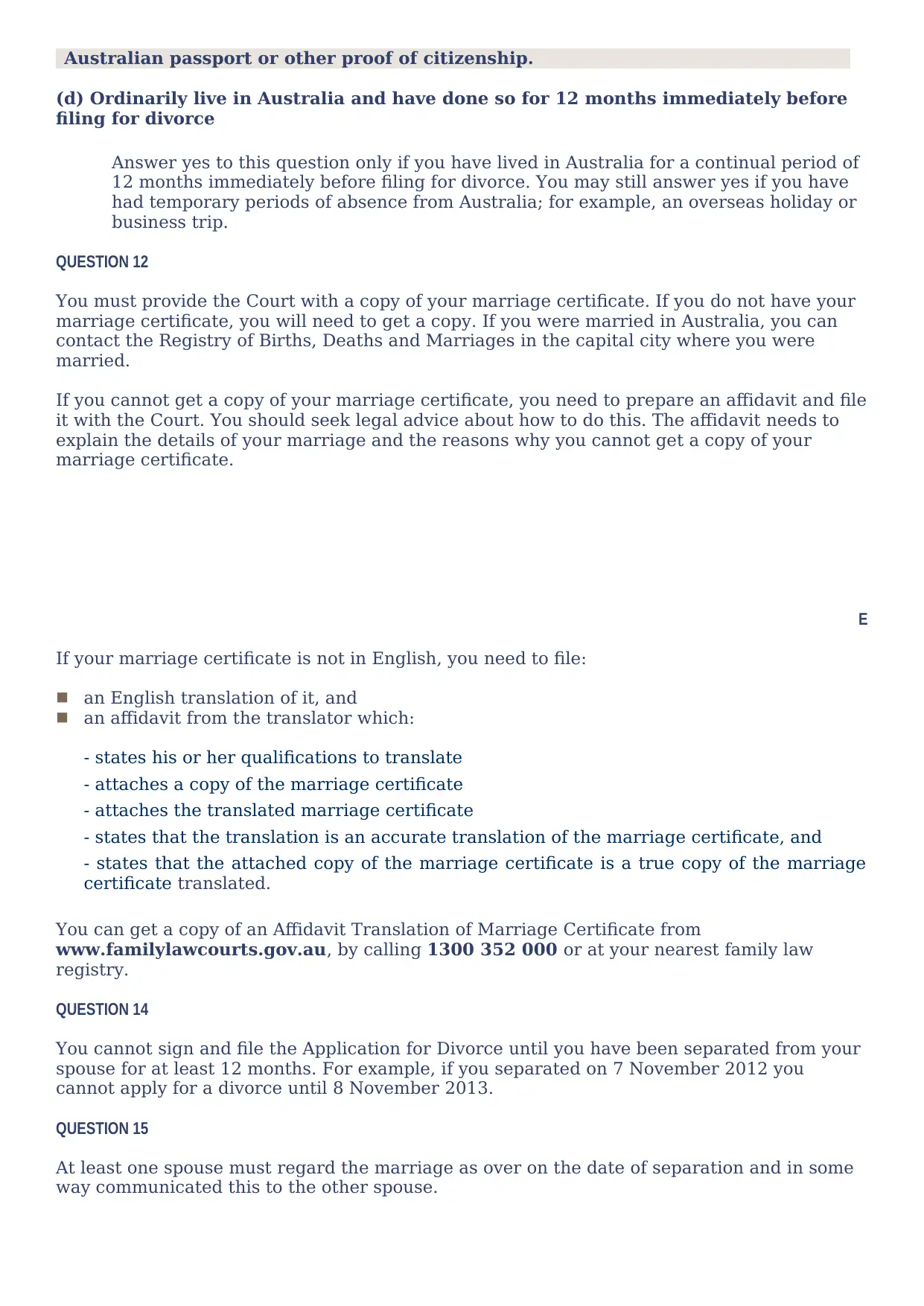
Australian passport or other proof of citizenship.
(d) Ordinarily live in Australia and have done so for 12 months immediately before
filing for divorce
Answer yes to this question only if you have lived in Australia for a continual period of
12 months immediately before filing for divorce. You may still answer yes if you have
had temporary periods of absence from Australia; for example, an overseas holiday or
business trip.
QUESTION 12
You must provide the Court with a copy of your marriage certificate. If you do not have your
marriage certificate, you will need to get a copy. If you were married in Australia, you can
contact the Registry of Births, Deaths and Marriages in the capital city where you were
married.
If you cannot get a copy of your marriage certificate, you need to prepare an affidavit and file
it with the Court. You should seek legal advice about how to do this. The affidavit needs to
explain the details of your marriage and the reasons why you cannot get a copy of your
marriage certificate.
E
If your marriage certificate is not in English, you need to file:
an English translation of it, and
an affidavit from the translator which:
- states his or her qualifications to translate
- attaches a copy of the marriage certificate
- attaches the translated marriage certificate
- states that the translation is an accurate translation of the marriage certificate, and
- states that the attached copy of the marriage certificate is a true copy of the marriage
certificate translated.
You can get a copy of an Affidavit Translation of Marriage Certificate from
www.familylawcourts.gov.au, by calling 1300 352 000 or at your nearest family law
registry.
QUESTION 14
You cannot sign and file the Application for Divorce until you have been separated from your
spouse for at least 12 months. For example, if you separated on 7 November 2012 you
cannot apply for a divorce until 8 November 2013.
QUESTION 15
At least one spouse must regard the marriage as over on the date of separation and in some
way communicated this to the other spouse.
(d) Ordinarily live in Australia and have done so for 12 months immediately before
filing for divorce
Answer yes to this question only if you have lived in Australia for a continual period of
12 months immediately before filing for divorce. You may still answer yes if you have
had temporary periods of absence from Australia; for example, an overseas holiday or
business trip.
QUESTION 12
You must provide the Court with a copy of your marriage certificate. If you do not have your
marriage certificate, you will need to get a copy. If you were married in Australia, you can
contact the Registry of Births, Deaths and Marriages in the capital city where you were
married.
If you cannot get a copy of your marriage certificate, you need to prepare an affidavit and file
it with the Court. You should seek legal advice about how to do this. The affidavit needs to
explain the details of your marriage and the reasons why you cannot get a copy of your
marriage certificate.
E
If your marriage certificate is not in English, you need to file:
an English translation of it, and
an affidavit from the translator which:
- states his or her qualifications to translate
- attaches a copy of the marriage certificate
- attaches the translated marriage certificate
- states that the translation is an accurate translation of the marriage certificate, and
- states that the attached copy of the marriage certificate is a true copy of the marriage
certificate translated.
You can get a copy of an Affidavit Translation of Marriage Certificate from
www.familylawcourts.gov.au, by calling 1300 352 000 or at your nearest family law
registry.
QUESTION 14
You cannot sign and file the Application for Divorce until you have been separated from your
spouse for at least 12 months. For example, if you separated on 7 November 2012 you
cannot apply for a divorce until 8 November 2013.
QUESTION 15
At least one spouse must regard the marriage as over on the date of separation and in some
way communicated this to the other spouse.
⊘ This is a preview!⊘
Do you want full access?
Subscribe today to unlock all pages.

Trusted by 1+ million students worldwide
1 out of 37
Your All-in-One AI-Powered Toolkit for Academic Success.
+13062052269
info@desklib.com
Available 24*7 on WhatsApp / Email
![[object Object]](/_next/static/media/star-bottom.7253800d.svg)
Unlock your academic potential
Copyright © 2020–2025 A2Z Services. All Rights Reserved. Developed and managed by ZUCOL.

